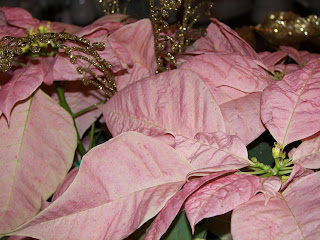 |
| Poinsetia |
Numerous meanings were attributed to plant life before we began to understand their components. Pagan superstitions persisted into the twentieth century. Some still remain as part of Christmas traditions.
“O Christmas Tree, O Christmas Tree, Your branches green delight us.” “Oh Tannenbaum, oh Tannenbaum, Wie grün sind deine Blätter!” Written in 1823 by Ernst Anschutz.
Tannenbaum is a fir tree. Christmas trees and other evergreens were symbolic of long life and hope and associated with seasonal celebrations since ancient times. Long before the Christmas tree, people believed that evergreens would keep away witches, ghosts, evil spirits and illness.
In 16th-century Germany, fir trees were decorated, both indoors and out, with apples that depicted the story of Adam and Eve's expulsion from the Garden of Eden.
Martin Luther first adorned trees with light. While coming home one December evening, the beauty of the stars shining through the branches of a fir inspired him to recreate the effect by placing candles on the branches of a small fir tree inside his home. (Do not light real candles on your tree today!)
The Christmas tree was brought to England by Queen Victoria's husband, Prince Albert, from his native Germany. Brought to America by the Pennsylvania Germans, the Christmas tree was being used here by the late 19th century.
“The best Christmas trees come very close to exceeding nature." ~ Andy Rooney.
Here are some suggestions for creating your own best “all natural trees.”
A natural tree is either cut fresh or with a root ball for planting. For those that worry about cutting trees, make your choice from tree farms that has a proven cut-to-plant ratio of one harvested to one or more planted. Tree farms are run by farmers. It’s a crop.
For tree care & environmental disposal hints see: http://www.christmastree.org/
Decorate with some of the following:
As soon as the tree starts to dry, it should be removed from the home. A natural tree and eatable decorations can benefit wildlife after it’s placed outside.
No matter if you “deck your halls” with an aluminum tree and flashing lights or an all natural tree, may you be blessed this Christmas season.
“O Christmas Tree, O Christmas Tree, Your branches green delight us.” “Oh Tannenbaum, oh Tannenbaum, Wie grün sind deine Blätter!” Written in 1823 by Ernst Anschutz.
Tannenbaum is a fir tree. Christmas trees and other evergreens were symbolic of long life and hope and associated with seasonal celebrations since ancient times. Long before the Christmas tree, people believed that evergreens would keep away witches, ghosts, evil spirits and illness.
In 16th-century Germany, fir trees were decorated, both indoors and out, with apples that depicted the story of Adam and Eve's expulsion from the Garden of Eden.
Martin Luther first adorned trees with light. While coming home one December evening, the beauty of the stars shining through the branches of a fir inspired him to recreate the effect by placing candles on the branches of a small fir tree inside his home. (Do not light real candles on your tree today!)
The Christmas tree was brought to England by Queen Victoria's husband, Prince Albert, from his native Germany. Brought to America by the Pennsylvania Germans, the Christmas tree was being used here by the late 19th century.
“The best Christmas trees come very close to exceeding nature." ~ Andy Rooney.
Here are some suggestions for creating your own best “all natural trees.”
A natural tree is either cut fresh or with a root ball for planting. For those that worry about cutting trees, make your choice from tree farms that has a proven cut-to-plant ratio of one harvested to one or more planted. Tree farms are run by farmers. It’s a crop.
For tree care & environmental disposal hints see: http://www.christmastree.org/
Decorate with some of the following:
- Strings of popcorn & cranberries
- Pinecones & nuts tied with recycled ribbons, twine or raffia
- Paper chains from recycled colored paper
- Dried flowers, wheat clusters, feathers, & seed pods
- Starfish & sand dollars
- Holly
- Painted egg shells
- Cookie ornaments
- Parts of old Christmas cards & pictures of family.
- Things you have on hand such as stuffed animals
- Candy canes, orange pomander balls, & apples.
As soon as the tree starts to dry, it should be removed from the home. A natural tree and eatable decorations can benefit wildlife after it’s placed outside.
No matter if you “deck your halls” with an aluminum tree and flashing lights or an all natural tree, may you be blessed this Christmas season.
No comments:
Post a Comment